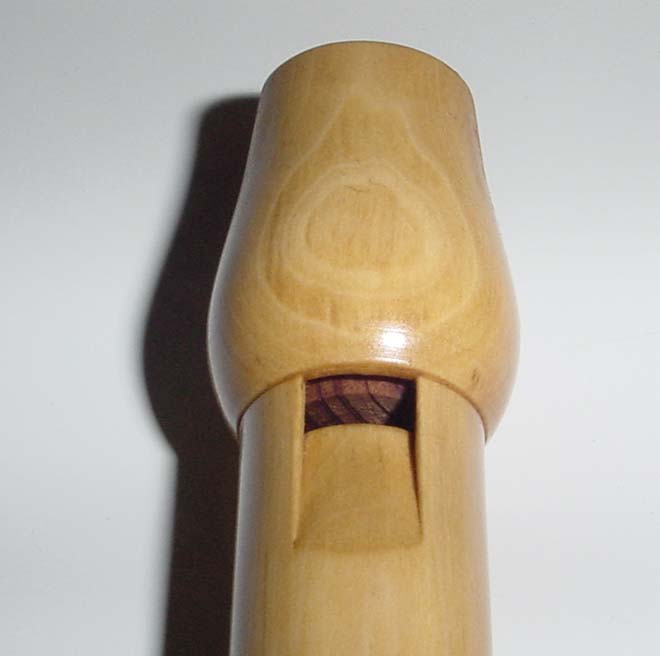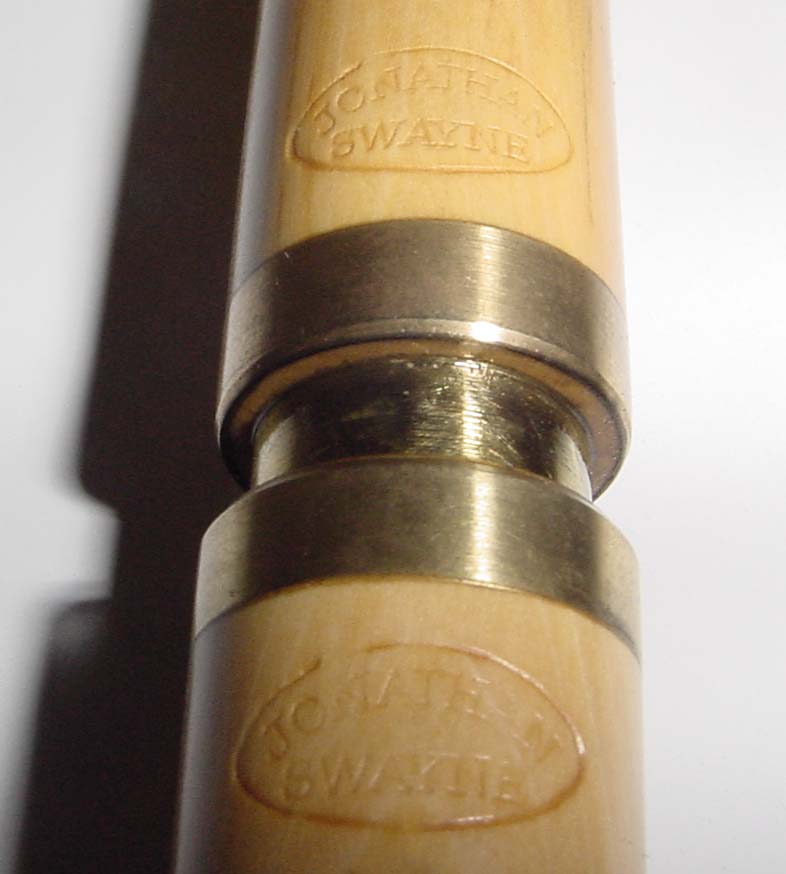Swayne Soprano D whistle Review
(Review written February 2006)
- Preface
- In the course of reviewing whistles, I've found it difficult to get certain brands easily. Swayne, Grinter, Rose, Bleazey, to name a few. These particular whistles don't come up for sale very often, and they're popular enough that the makers already have enough business without sending off a free whistle for review. People who own them almost always have good things to say about them, but because of costs and waiting lists, the sample size of owners that I've heard from on message boards is small. Imagine my delight when a fellow whistler offered to loan me his boxwood Swayne and Bleazey for review! Wow! I was fairly surprised at the similarities between them, which you'll see when I get the Bleazey reviewed.
- At a Glance
- Whistle Reviewed
- Swayne Soprano D whistle
- Models Available
- G, D, C, Bb, A, G, F, and low D in boxwood
- How Acquired
- On loan (thanks Charlie!)
- Construction
- boxwood with brass mounts and slide. Occasionally works in blackwood on request.
- Price at Time of Review (in US Dollars unless otherwise noted)
- £135.00 (about $235 USD)
- Available From
-
Direct from Jonathan Swayne
- Appearance
- The Swayne is a really neat-looking instrument. The workmanship is superb. The design deviates from the average tinwhistle in a couple of respects. The first thing you'll notice is the tulip-shaped mouthpiece. The second is the thicker, curved bell end of the whistle. I don't think these make the whistle look too much like a recorder, but I think they do make it look a bit exotic, and may make it fit in a little better at period events like Renaissance festivals. This whistle was very photogenic, too. I didn't have to work at all to get great looking pictures of it!
-

Here's the full whistle.
Here's a close-up of the mouthpiece. You can't see it, but the mouthpiece is held together by a very small pin on either side.
Here's another angle on the mouthpiece, showing the fipple area. I love the look of that cedar and boxwood next to each other.
You can't see it, because it's assembled, but the tuning slide on this whistle isn't very long. It's a lot like an Abell in that respect. But it's plenty long enough to get the job done. The brass mounts and slide didn't tarnish the whole time I had the whistle, and it stayed nice and classy looking. The slide itself works superbly, sliding when it needs to without too much force, but gripping tightly and staying put once I had it in place.You can also see Jon's logo here, which is a very nice touch.

A shot at the end of the whistle, showing the last three holes. I also kept the foot of the whistle in the picture, so you could see the curvature I mentioned before. I think the slight curvature at the bell makes the whistle a little more comfortable for me to play when I drop my pinkie down.
- Playing Characteristics
- Fast playing whistle, with a strong tone and a slight reediness. I say slight, becuase it's not that reedy, but you can definitely hear it when you play the whistle back-to-back next to a purer toned instrument (like the Bleazey). The whistle has a nice tight amount of chiff at the start of a tongued note.
-
Sound clips of the whistle:
Gravel Walk
Mo Ghile MearVolume: Slighly above average volume. The first octave and the second octave are actually quite close to each other in volume, which is nice. Tt really doesn't get loud until the 2nd octave A and B. Mostly, the whistle plays a shade louder than an average cheapie like a Generation or Sweetone.
Responsiveness: Fast. This whistle can take everything I can dish out.
Tuning: Jon has mentioned to Dale Wisely of Chiff and Fipple that his whistles optimized for an octave and a sixth tuning range. I found this whistle in tune across the entire two octave range. The A and B require slightly more push in the first octave, and the second octave F# requires more push, too (which can make you want to overblow the G when you get up there). But these pushes are well within normal range that'd I'd expect when getting to know a new whistle. they aren't extreme or what I'd consider "breath gymnastics".
C-natural: OXXOOO plays a perfect C-Natural. For that matter, so does OXXOXX and OXXOOX. Take your pick! OXOOOO is about 20 cents sharp, but I only use that fingering when I'm flipping through a fast run on a reel, and I doubt it's that noticeable then.
Hole size and placement: The holes are fairly evenly spaced, and on the smaller side of average. Like most whistles, the E and F# are closer together, but not so close on this whistle that my finger's touch.
Air volume requirements: Low. I can get through 2 reps of an A part, and a full B part on one big lungful. This whistle is very easy to play in that department.
Air pressure requirements: Average. The whistle is pretty easy blowing in the second octave, going up in requirements as you go up the scale. The 2nd octave B only requires slightly more push than the Generation D I pulled out of my whistle drawer.
Clogging: I never really noticed that much clogging playing this whistle. I don't think I'd need to give it any kind of treatment.
Wind Resistance: Medium. It will take a fairly good wind, but if it cuts directly perpendicular to the wind channel, you're out of luck. But this definitely minimizes the amount of wind shifting you have to do out of doors.
- Summary
- This is a solid performing whistle with a great tone. For what it's worth, Sean Smyth of Lunasa plays a Swayne, and I can see why. Now that I've played this whistle for a couple of weeks, I'm going to be getting on this waiting list and get one of my own. I can't really endorse it any more than that!